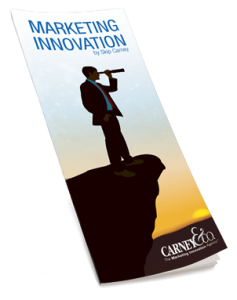Tag: Steve Jobs
 Every MBA school in America will tell you the importance of a 5 year plan. You have to have a clear vision of where you are headed, where your business will be, and what it will LOOK like five years from now. How many employees, how many customers, what kind of product mix? You have to have vision.
Every MBA school in America will tell you the importance of a 5 year plan. You have to have a clear vision of where you are headed, where your business will be, and what it will LOOK like five years from now. How many employees, how many customers, what kind of product mix? You have to have vision.
Five years from now is 2020. So, do you have 2020 vision? Is it enough?
Frankly, I think the five year plan is overrated.
I’ll bet Motorola had a five year plan. So did Sears and Palm and General Motors and Eastern Airlines and they probably all had 5 year committees and strategy teams, too.
The problem with most five year plans is they often fail to take into account the most important and unpredictable factor in the equation – the customer. The customer doesn’t have a five year plan. The customer wants what she wants, when she wants it, and as soon as somebody offers her a better widget, she’s going to want that new widget. Now. Your plans be damned. Bean counters and MBAs spend countless hours plotting strategies to maximize profits, streamline performance, and increase ROI assuming the future is going to look very much like the present.
 The answer is NOT another focus group.
The answer is NOT another focus group.
Henry Ford said if he had asked his customers what they wanted, they would have said “A faster horse.” He was right of course. His five year plan was not to build a car. It was to build a better mode of personal transportation. The result was a car.
No, real visionaries aren’t looking at their balance sheet in five years, they are looking at their customers now and how they might make their lives better in five years. The companies that lead year after year are the companies that focus on innovation… creative solutions to their customers’ problems. Those companies see change happening before it happens, usually because they are creating the change. The companies that aren’t innovating see the changes too late and find their business model, as well as their five year plans, irrelevant and obsolete.
 So, if you want 2020 vision, focus on solving your customers’ problems in new and exciting ways and you’ll be surprised how clear the future becomes.
So, if you want 2020 vision, focus on solving your customers’ problems in new and exciting ways and you’ll be surprised how clear the future becomes.
No doubt about it, innovation is the buzzword of the decade, maybe the century. From Amazon to Zappos, innovation abounds and companies strive to emulate, replicate, and instigate it. The latest, disturbing trend is the Department of Innovation and the inevitable VP of Innovation. There are 7628 listings on Indeed.com that include the word “innovation” in the title or job description. Likewise, Linkedin.com.
What are these people thinking?
“We ne ed it. We don’t know what it is, but we gotta have it so let’s put somebody in charge of it.” I’ve heard it more times than I can count and I am convinced this may be the absolute fastest way to go out of business. An entire company will sit around waiting for the “VP of I” to hand down insights and revelations. Not even Steve Jobs could handle that kind of pressure. The greatest, most innovative companies are not led by “innovators”. They are led by people who inspire innovation while demanding excellence and focus.
ed it. We don’t know what it is, but we gotta have it so let’s put somebody in charge of it.” I’ve heard it more times than I can count and I am convinced this may be the absolute fastest way to go out of business. An entire company will sit around waiting for the “VP of I” to hand down insights and revelations. Not even Steve Jobs could handle that kind of pressure. The greatest, most innovative companies are not led by “innovators”. They are led by people who inspire innovation while demanding excellence and focus.
The truth about innovation.
Innovation doesn’t come from a department, and rarely does it spring from a single person. It comes from a commitment to problem-solving. Companies that are committed to solving their customers’ problems always find ways to innovate, sometimes by accident, sometimes on purpose. The point is, they are always looking for opportunities to innovate. 3M and Proctor and Gamble rarely make the headlines, but they get it, and that’s why they’ve excelled as long as they have.
It has to be in your culture.
So, don’t tell your team that you’ve decided to become an innovation organization. Instead, get everyone to start identifying and solving customer problems all the time. Create a culture of innovation. (Just don’t call it that.) The ideas will flow, the solutions will come, and your customers will recognize and reward the effort.
Wherever Steve Jobs is perched as he watches the latest twists and turns at Apple, you know he has to be laughing. The idea that people are upset when they sit on their very thin, very light phone and it bends is too funny for words. It’s almost as good as the countless people who have dropped their phones in the toilet and act like it’s someone else’s fault that they are trying to multi-task in the john. Seriously, people. Don’t mess with your phone when you are messing with your mess. It’s just not kosher.
While Steve may be laughing, he is definitely not smiling.

PC users might be used to sloppy product introductions and instructions that don’t make sense. Mac users, on the other hand, do not suffer fools lightly. So, when we open an iWork document and we get a message that says to upgrade to Yosemite, we expect Yosemite to actually be available for download. When it’s not, we start to miss Steve. It’s this kind of insane attention to detail that made the Apple brand synonymous with user-friendly, common sense, plug ‘n play operation.
Sure, we have now downloaded Yosemite and it’s working beautifully, just as we expect. Meanwhile, the damage is done. A tiny spec of rust on an otherwise shiny brand. It will not be the end of Apple any more than a bent iPhone will be the end of Apple. All it means for now is some of Apple’s raving fans aren’t smiling. And that means Steve isn’t smiling.
Albert Einstein once said, “If at first the idea is not absurd, then there is no hope for it.” Steve Jobs took those words to heart. Every innovation he envisioned was at first considered absurd, undoable, and generally far-fetched.
Lesson One: If the idea is right and you know it, it doesn’t matter if everyone thinks it is absurd.
When he conceived the idea for The Apple Store, he took it to his board…all smart, successful people who had witnessed his magic first hand…the immediate response was ‘no way’. Gateway was closing stores left and right and no other computer manufacturer had been able to succeed at retail. The Apple Store is now the most successful retail concept in history. More sales per square foot, more sales per store, more profit, than any other retail store selling anything.
Lesson Two: He never took no for an answer.
iPod and iTunes revolutionized and saved the music industry. As brilliant and beautifully simple as the iPod was, it was just a music player with iTunes. And iTunes would be nothing without the consent of the music industry. One by one, Steve personally visited every major music publisher. One by one, he convinced them to give the iTunes model a try. He hoped to sell one million songs in six months. He sold one million in six days. Even in the light of that early success, there were holdouts. Most notably, the Beatles. He never gave up and in 2011, the Beatles joined iTunes.
Lesson Three: Never stop selling.
Steve Jobs was not just a genius, not just a visionary. There are many geniuses in the world who are unknown and have contributed little to our world. Jobs was different. He was a salesman. A Master Salesman. He believed in his product. He believed in its value. He believed he could help people if he could just help them understand. He kept working until they understood.
This, I believe is the real genius of Steve Jobs. He was smart enough to realize that all good ideas must be sold. And the best ideas have to be sold more.
What I’ve learned from Steve Jobs, so far…Never never never stop selling.

